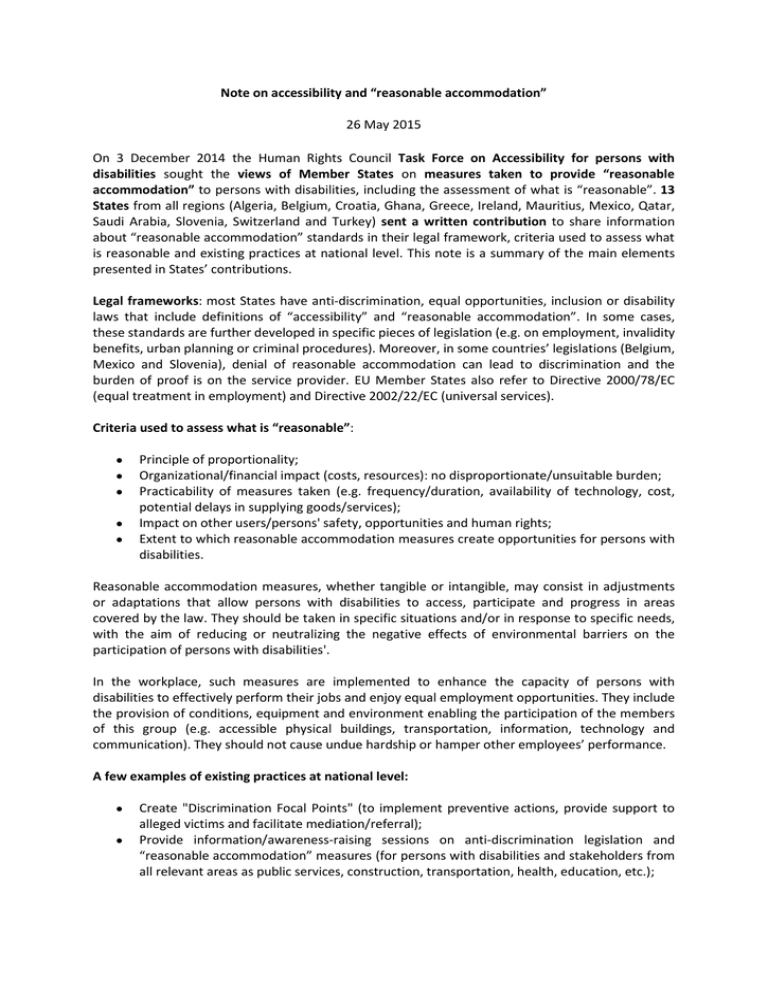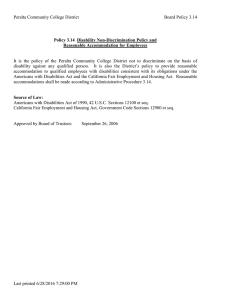Note on accessibility and “reasonable accommodation” disabilities accommodation”
advertisement

Note on accessibility and “reasonable accommodation” 26 May 2015 On 3 December 2014 the Human Rights Council Task Force on Accessibility for persons with disabilities sought the views of Member States on measures taken to provide “reasonable accommodation” to persons with disabilities, including the assessment of what is “reasonable”. 13 States from all regions (Algeria, Belgium, Croatia, Ghana, Greece, Ireland, Mauritius, Mexico, Qatar, Saudi Arabia, Slovenia, Switzerland and Turkey) sent a written contribution to share information about “reasonable accommodation” standards in their legal framework, criteria used to assess what is reasonable and existing practices at national level. This note is a summary of the main elements presented in States’ contributions. Legal frameworks: most States have anti-discrimination, equal opportunities, inclusion or disability laws that include definitions of “accessibility” and “reasonable accommodation”. In some cases, these standards are further developed in specific pieces of legislation (e.g. on employment, invalidity benefits, urban planning or criminal procedures). Moreover, in some countries’ legislations (Belgium, Mexico and Slovenia), denial of reasonable accommodation can lead to discrimination and the burden of proof is on the service provider. EU Member States also refer to Directive 2000/78/EC (equal treatment in employment) and Directive 2002/22/EC (universal services). Criteria used to assess what is “reasonable”: Principle of proportionality; Organizational/financial impact (costs, resources): no disproportionate/unsuitable burden; Practicability of measures taken (e.g. frequency/duration, availability of technology, cost, potential delays in supplying goods/services); Impact on other users/persons' safety, opportunities and human rights; Extent to which reasonable accommodation measures create opportunities for persons with disabilities. Reasonable accommodation measures, whether tangible or intangible, may consist in adjustments or adaptations that allow persons with disabilities to access, participate and progress in areas covered by the law. They should be taken in specific situations and/or in response to specific needs, with the aim of reducing or neutralizing the negative effects of environmental barriers on the participation of persons with disabilities'. In the workplace, such measures are implemented to enhance the capacity of persons with disabilities to effectively perform their jobs and enjoy equal employment opportunities. They include the provision of conditions, equipment and environment enabling the participation of the members of this group (e.g. accessible physical buildings, transportation, information, technology and communication). They should not cause undue hardship or hamper other employees’ performance. A few examples of existing practices at national level: Create "Discrimination Focal Points" (to implement preventive actions, provide support to alleged victims and facilitate mediation/referral); Provide information/awareness-raising sessions on anti-discrimination legislation and “reasonable accommodation” measures (for persons with disabilities and stakeholders from all relevant areas as public services, construction, transportation, health, education, etc.); Make free assistance available for the planning and construction of accessible public infrastructure (e.g. from a specialized architect); Create awards for entities that apply universal design; Implement access audits of premises/buildings/facilities; Create quotas for employment of persons with disabilities in public administrations. If qualified candidates cannot be found, make sure alternate measures are available (e.g. business cooperation with companies that employ persons with disabilities); Adapt workplaces (widened access areas, ramps, handrails, elevators, raising or lowering equipment, special holding devices, etc.), workstations (screen magnification, special chairs, etc.), work schedules, career plans, etc.; Explore formats to make oral communications accessible to persons with hearing impairments: hearing aids, visual support, written versions of oral communications, sign language interpretation, real time captioning, induction loops in reception areas/meeting rooms, provision of text/video phones, use of descriptive texts for promotional videos, etc.; Explore formats to make written information accessible to persons with visual impairments: use of large print, high contrast, audio tapes, texts in Braille, etc.; Make sure to understand the needs of persons using adaptive technology as screen readers, screen magnification software, speaking browsers, etc.; Produce information in "easy to read" format/summaries; Provide computer equipment with functions for disabled end-users; Provide support of personal assistants; Provide services with reduced costs for persons with disabilities (such as Internet, telephony, etc.); Carry out situation analysis on integrated services accessible to persons with disabilities; Hold consultations with representative groups (e.g. DPOs) on appropriate types of assistance (consumers panels); Provide coaching services for employees/employers (to facilitate agreement on reasonable adjustments/adaptations); Ensure an “access officer” is responsible for coordinating assistance to persons with disabilities; Create accessible complaint mechanisms/procedures; In application forms for conferences, make sure participants are invited to list their specific needs; Review procurement policies to build accessibility into the procurement process; When necessary, create new assignments for employees who have developed a disability. ----


